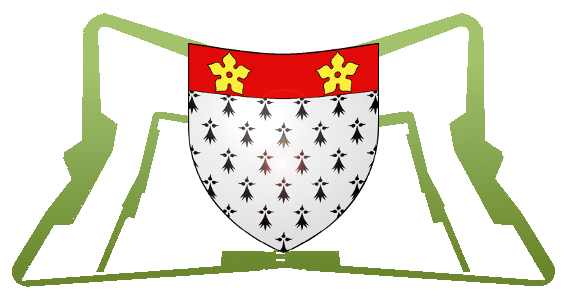Constance Chlore
 Gaius Flavius Valerius Constantius, was a
Roman general who became emperor in 305. He was nicknamed Chlorus, from the Greek word for pale,
because of the pallor of his skin. In 298, when the Alemanni from Germany attacked Gaulle, Constantius defeated them in a battle beneath the
walls of Langres.
Gaius Flavius Valerius Constantius, was a
Roman general who became emperor in 305. He was nicknamed Chlorus, from the Greek word for pale,
because of the pallor of his skin. In 298, when the Alemanni from Germany attacked Gaulle, Constantius defeated them in a battle beneath the
walls of Langres.
In 1886-1887, the Minister of War, General Boulanger, decided to give all barracks and forts code names recalling military commanders or illustrious battles. Thus the inscription above the gates.
A detached fort of the defensive perimeter of Langres
The Fort of Peigney is one of eight detached forts built in the late 19th century around Langres in the Haute-Marne to protect the town against a German attack.

Structure

- Entrance
- Officers' barracks
- Explosives magazines
- Soldiers' barracks
- Wells
- Gun emplacements
- Protected galleries
* Note that the dark green represents the dry moats.
History

Located about two kilometres northeast of Langres, and 400 metres from the village of Peigney, the fort was built to defend the valley of the river Marne, the roads to Metz (in German-occupied Moselle after 1871) and Basel in Switzerland, and the railway northwards to Chaumont.
Its construction, begun in 1869, was almost completed before the Franco-Prussian War in 1870. After the war, the fort was restored and the work lasted until 1875.

As a result of the defeat of France, Alsace and Moselle, in the north-eastern corner of France, became part of Germany from 1871 until 1919. General Séré de Rivières directed the building of new fortifications to defend this modified border. Thus Langres became a part of the second line of fortified towns. The first line was divided into two sections: one from Verdun to Toul, the other from Épinal to Belfort. The gap between Toul and Épinal, known as the "trouée de Charmes", was defended by Langres.
The fort of Peigney is in the shape of a trapezium with a maximum width of 450 metres, with two dry moats. In the courtyard are two barracks for 800 officers and men.
The fort was never attacked. During the First World War it was disarmed and the guns were sent to the front. In March 1916, enough explosives were left in the magazines to sabotage the fort in case of an enemy approach. In 1917, the fort served as a rear base. In December, the French army allowed Colonel John H. Parker (Gatling Gun Parker) of the Americian Army to establish the Army Machine-Gun School at the fort.

During the Nazi occupation in the Second World War, between 1941 and 1943, the fort was an internment camp for the local Gypsy population. At the end of the war, German prisonners were interned there. Today it belongs to the town of Peigney, after having been used for several years by the Sécurité Civile (fire brigade).
Fort de Peigney © 2015 - 2019


